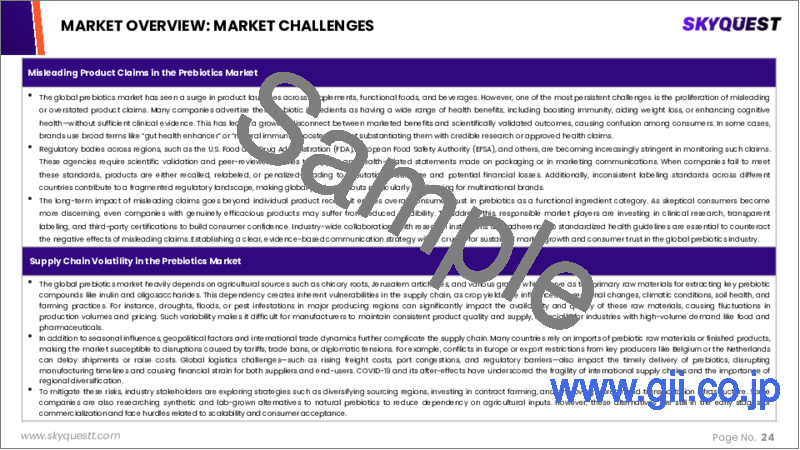|
|
市場調査レポート
商品コード
1670391
プレバイオティクス市場規模、シェア、成長分析:成分別、用途別、地域別 - 産業予測 2025~2032年Prebiotics Market Size, Share, and Growth Analysis, By Ingredients (Fructo-oligosaccharide (FOS), Inulin), By Application (Prebiotic Food & Beverages, Prebiotic dietary Supplements), By Region - Industry Forecast 2025-2032 |
||||||
|
|||||||
| プレバイオティクス市場規模、シェア、成長分析:成分別、用途別、地域別 - 産業予測 2025~2032年 |
|
出版日: 2025年02月28日
発行: SkyQuest
ページ情報: 英文 198 Pages
納期: 3~5営業日
|
全表示
- 概要
- 目次
プレバイオティクス市場規模は2023年に79億9,000万米ドルと評価され、2024年の91億8,000万米ドルから2032年には278億9,000万米ドルに成長し、予測期間(2025-2032年)のCAGRは14.9%で成長する見通しです。
米国プレバイオティクス市場は、健康意識の高まりと栄養補助食品需要の増加を背景に、次の予測期間を通じて大きく成長するとみられます。イヌリンとオリゴ糖を製造する技術の進歩が砂糖市場のシェアを低下させると予想される一方、食物繊維の健康上の利点に関する消費者の認識の変化がこの動向を後押しします。便秘、過敏性腸症候群、炎症性腸疾患といった胃腸の問題が増加する中、腸の健康をめぐる関心が高まっており、市場の拡大をさらに後押ししています。プレバイオティックハーブの栽培増加やメーカーによる研究開発への投資は、革新的な製品の発表を目指しており、健康管理における積極的なアプローチを可能にしています。さらに、プレバイオティクスは食品の食感を向上させ、低カロリー甘味料としての役割を果たすという2つの役割を果たすことから、飲食品分野での重要性が強調されています。
目次
イントロダクション
- 調査の目的
- 調査範囲
- 定義
調査手法
- 情報調達
- 二次と一次データの方法
- 市場規模予測
- 市場の前提条件と制限
エグゼクティブサマリー
- 世界市場の見通し
- 供給と需要の動向分析
- セグメント別機会分析
市場力学と見通し
- 市場概要
- 市場規模
- 市場力学
- 促進要因と機会
- 抑制要因と課題
- ポーターの分析
主な市場の考察
- 重要成功要因
- 競合の程度
- 主な投資機会
- 市場エコシステム
- 市場の魅力指数(2024年)
- PESTEL分析
- マクロ経済指標
- バリューチェーン分析
- 価格分析
- 規制分析
- 特許分析
プレバイオティクス市場規模:成分別& CAGR(2025-2032)
- 市場概要
- フルクトオリゴ糖(FOS)
- イヌリン
- ガラクトオリゴ糖(GOS)
- マンナンオリゴ糖(MOS)
- その他(オリゴ糖チコリフルクタンHMOXOS)
プレバイオティクス市場規模:用途別& CAGR(2025-2032)
- 市場概要
- プレバイオティクス食品・飲料
- 乳製品
- シリアル
- 焼き菓子
- 発酵肉製品
- ドライフードプレバイオティクス
- その他
- プレバイオティクス栄養補助食品
- 食品サプリメント
- 栄養補助食品
- 特殊栄養素
- 乳児用食品
- 動物飼料プレバイオティクス
プレバイオティクス市場規模:地域別& CAGR(2025-2032)
- 北米
- 米国
- カナダ
- 欧州
- ドイツ
- スペイン
- フランス
- 英国
- イタリア
- その他欧州地域
- アジア太平洋地域
- 中国
- インド
- 日本
- 韓国
- その他アジア太平洋地域
- ラテンアメリカ
- ブラジル
- その他ラテンアメリカ地域
- 中東・アフリカ
- GCC諸国
- 南アフリカ
- その他中東・アフリカ
競合情報
- 上位5社の比較
- 主要企業の市場ポジショニング(2024年)
- 主な市場企業が採用した戦略
- 最近の市場動向
- 企業の市場シェア分析(2024年)
- 主要企業の企業プロファイル
- 企業の詳細
- 製品ポートフォリオ分析
- 企業のセグメント別シェア分析
- 収益の前年比比較(2022-2024)
主要企業プロファイル
- Ingredion(United States)
- Givaudan(Switzerland)
- Hain Celestial Group(United States)
- Cargill(United States)
- Archer Daniels Midland Company(United States)
- Tate & Lyle(United Kingdom)
- BENEO GmbH(Germany)
- FrieslandCampina(Netherlands)
- Kerry Group(Ireland)
- Yakult Honsha Co., Ltd.(Japan)
- Cosucra Groupe Warcoing SA(Belgium)
- Clasado Biosciences(United Kingdom)
- Royal DSM(Netherlands)
- Dupont Nutrition & Biosciences(United States)
- Nestle Health Science(Switzerland)
- Danone(France)
- Roquette Freres(France)
- FMC Corporation(United States)
- Aker Biomarine(Norway)
- Sabinsa Corporation(United States)
結論と提言
Prebiotics Market size was valued at USD 7.99 billion in 2023 and is poised to grow from USD 9.18 billion in 2024 to USD 27.89 billion by 2032, growing at a CAGR of 14.9% during the forecast period (2025-2032).
The US prebiotics market is set for significant growth through the next forecast period, driven by increasing health awareness and a rising demand for dietary supplements. Technological advancements in producing inulin and oligosaccharides are expected to decrease sugar market shares, while shifting consumer perceptions regarding the health benefits of fiber bolster this trend. With gastrointestinal issues such as constipation, irritable bowel syndrome, and inflammatory bowel disease on the rise, there's heightened concern surrounding gut health, further propelling market expansion. Increased cultivation of prebiotic herbs and investments in research and development by manufacturers aim to unveil innovative products, allowing for a proactive approach in health management. Moreover, the dual role of prebiotics in enhancing food texture and serving as low-calorie sweeteners underscores their importance in the food and beverage sector.
Top-down and bottom-up approaches were used to estimate and validate the size of the Prebiotics market and to estimate the size of various other dependent submarkets. The research methodology used to estimate the market size includes the following details: The key players in the market were identified through secondary research, and their market shares in the respective regions were determined through primary and secondary research. This entire procedure includes the study of the annual and financial reports of the top market players and extensive interviews for key insights from industry leaders such as CEOs, VPs, directors, and marketing executives. All percentage shares split, and breakdowns were determined using secondary sources and verified through Primary sources. All possible parameters that affect the markets covered in this research study have been accounted for, viewed in extensive detail, verified through primary research, and analyzed to get the final quantitative and qualitative data.
Prebiotics Market Segments Analysis
Global Prebiotics Market is segmented by Ingredients, Application and region. Based on Ingredients, the market is segmented into Fructo-oligosaccharide (FOS), Inulin, Galacto-oligosaccharides (GOS), Mannan-oligosaccharide (MOS) and Others (Oligosaccharides, Chicory Fructans, HMO, XOS). Based on Application, the market is segmented into Prebiotic Food & Beverages, Prebiotic dietary Supplements and Animal Feed Prebiotics. Based on region, the market is segmented into North America, Europe, Asia Pacific, Latin America and Middle East & Africa.
Driver of the Prebiotics Market
The Prebiotics market is being significantly driven by the rising recognition of the vital role that health and well-being play in people's lives. As consumers become more informed about the benefits of gut health, there is an escalating demand for functional foods and dietary supplements enriched with prebiotics. These ingredients are increasingly sought after for their ability to promote beneficial gut bacteria and enhance overall digestive health. This trend reflects a broader shift towards preventive health measures, as individuals actively seek out products that support their wellness journey and offer tangible health benefits, further fueling the growth of the prebiotics sector.
Restraints in the Prebiotics Market
Despite the increasing recognition of the significance of prebiotics, a considerable number of consumers remain unaware of their existence and the advantages they offer. This lack of understanding poses a challenge for the prebiotics market, as it limits consumer engagement and adoption. Educational efforts and effective marketing strategies are essential to bridge this knowledge gap, allowing individuals to appreciate the potential health benefits of incorporating prebiotics into their diets. Until consumers become more informed about these beneficial compounds and their role in promoting gut health, the growth potential of the prebiotics market may continue to face hurdles.
Market Trends of the Prebiotics Market
The prebiotics market is witnessing a significant shift towards natural and organic products, fueled by rising consumer awareness of health and wellness. As individuals increasingly prioritize gut health and holistic well-being, there is a growing preference for prebiotics derived from natural sources rather than synthetic alternatives. This trend has prompted manufacturers to innovate and develop a diverse range of organic prebiotic ingredients, catering to the health-conscious consumer base. Additionally, the clean-label movement is amplifying demand for transparency in sourcing and production processes, further driving the market toward prebiotics that align with consumer values of sustainability and authenticity.
Table of Contents
Introduction
- Objectives of the Study
- Scope of the Report
- Definitions
Research Methodology
- Information Procurement
- Secondary & Primary Data Methods
- Market Size Estimation
- Market Assumptions & Limitations
Executive Summary
- Global Market Outlook
- Supply & Demand Trend Analysis
- Segmental Opportunity Analysis
Market Dynamics & Outlook
- Market Overview
- Market Size
- Market Dynamics
- Drivers & Opportunities
- Restraints & Challenges
- Porters Analysis
- Competitive rivalry
- Threat of substitute
- Bargaining power of buyers
- Threat of new entrants
- Bargaining power of suppliers
Key Market Insights
- Key Success Factors
- Degree of Competition
- Top Investment Pockets
- Market Ecosystem
- Market Attractiveness Index, 2024
- PESTEL Analysis
- Macro-Economic Indicators
- Value Chain Analysis
- Pricing Analysis
- Regulatory Analysis
- Patent Analysis
Global Prebiotics Market Size by Ingredients & CAGR (2025-2032)
- Market Overview
- Fructo-oligosaccharide (FOS)
- Inulin
- Galacto-oligosaccharides (GOS)
- Mannan-oligosaccharide (MOS)
- Others (Oligosaccharides, Chicory Fructans, HMO, XOS)
Global Prebiotics Market Size by Application & CAGR (2025-2032)
- Market Overview
- Prebiotic Food & Beverages
- Dairy Products
- Cereals
- Baked Food
- Fermented Meat Products
- Dry Food Prebiotics
- Others
- Prebiotic dietary Supplements
- Food Supplements
- Nutritional Supplements
- Specialty Nutrients
- Infant Foods
- Animal Feed Prebiotics
Global Prebiotics Market Size & CAGR (2025-2032)
- North America (Ingredients, Application)
- US
- Canada
- Europe (Ingredients, Application)
- Germany
- Spain
- France
- UK
- Italy
- Rest of Europe
- Asia Pacific (Ingredients, Application)
- China
- India
- Japan
- South Korea
- Rest of Asia-Pacific
- Latin America (Ingredients, Application)
- Brazil
- Rest of Latin America
- Middle East & Africa (Ingredients, Application)
- GCC Countries
- South Africa
- Rest of Middle East & Africa
Competitive Intelligence
- Top 5 Player Comparison
- Market Positioning of Key Players, 2024
- Strategies Adopted by Key Market Players
- Recent Developments in the Market
- Company Market Share Analysis, 2024
- Company Profiles of All Key Players
- Company Details
- Product Portfolio Analysis
- Company's Segmental Share Analysis
- Revenue Y-O-Y Comparison (2022-2024)
Key Company Profiles
- Ingredion (United States)
- Company Overview
- Business Segment Overview
- Financial Updates
- Key Developments
- Givaudan (Switzerland)
- Company Overview
- Business Segment Overview
- Financial Updates
- Key Developments
- Hain Celestial Group (United States)
- Company Overview
- Business Segment Overview
- Financial Updates
- Key Developments
- Cargill (United States)
- Company Overview
- Business Segment Overview
- Financial Updates
- Key Developments
- Archer Daniels Midland Company (United States)
- Company Overview
- Business Segment Overview
- Financial Updates
- Key Developments
- Tate & Lyle (United Kingdom)
- Company Overview
- Business Segment Overview
- Financial Updates
- Key Developments
- BENEO GmbH (Germany)
- Company Overview
- Business Segment Overview
- Financial Updates
- Key Developments
- FrieslandCampina (Netherlands)
- Company Overview
- Business Segment Overview
- Financial Updates
- Key Developments
- Kerry Group (Ireland)
- Company Overview
- Business Segment Overview
- Financial Updates
- Key Developments
- Yakult Honsha Co., Ltd. (Japan)
- Company Overview
- Business Segment Overview
- Financial Updates
- Key Developments
- Cosucra Groupe Warcoing SA (Belgium)
- Company Overview
- Business Segment Overview
- Financial Updates
- Key Developments
- Clasado Biosciences (United Kingdom)
- Company Overview
- Business Segment Overview
- Financial Updates
- Key Developments
- Royal DSM (Netherlands)
- Company Overview
- Business Segment Overview
- Financial Updates
- Key Developments
- Dupont Nutrition & Biosciences (United States)
- Company Overview
- Business Segment Overview
- Financial Updates
- Key Developments
- Nestle Health Science (Switzerland)
- Company Overview
- Business Segment Overview
- Financial Updates
- Key Developments
- Danone (France)
- Company Overview
- Business Segment Overview
- Financial Updates
- Key Developments
- Roquette Freres (France)
- Company Overview
- Business Segment Overview
- Financial Updates
- Key Developments
- FMC Corporation (United States)
- Company Overview
- Business Segment Overview
- Financial Updates
- Key Developments
- Aker Biomarine (Norway)
- Company Overview
- Business Segment Overview
- Financial Updates
- Key Developments
- Sabinsa Corporation (United States)
- Company Overview
- Business Segment Overview
- Financial Updates
- Key Developments





